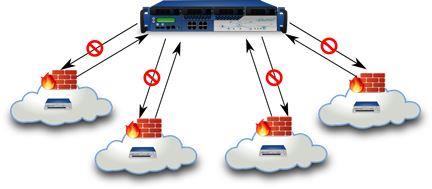
New remote probe used to have a deep insight to remote network and perform ISO/OSI level 2 action has been created by Sentinet3developer team
Remote probes must be placed in remote networks and communicate with the Sentinet3 appliance placed in Datacentre using a Restful protocol with the following characteristics: a) client (probe)/ server (Sentinet3)[/b] b)Stateless: no information stored between 2 different connections c) code on demand: probe can receive from server executable objects to extend its functionality. d) strong authenticationbetween client and server c)
Communication Encryption d) Unidirectional communication flow from probes to Sentinet3 Remote Probe will enable: a) Layer 2 Host and Service Autodiscovery that can go outside the gateway. b) Network intrusion in wan with not approved devices. c) Activate network probe as a NetFlow collector d) Activate probe as iperf source or destination Thanks to the above features we’ll be able to: a) Do automatic autodiscovery inside the wan and createautomatic server maps b) Perform a strict control over unauthorized access inside wan c) Have a strict control over network traffic d) Know the real available bandwithbetween two different sites.
 A great remote probe feature is the unidirectional data flow that enables Sentinet3 to show infrastructure state outside a protected network in read only mode.This feature enables Sentinet3 to be placed outside a protected network, without being able to enter inside the nework, and receive from probes information about states of services and server inside. The greatness of this feature is that it will enable IT administrators to have a perfect control over the entire network without being stuck inside the datacentre and without security problems.
A great remote probe feature is the unidirectional data flow that enables Sentinet3 to show infrastructure state outside a protected network in read only mode.This feature enables Sentinet3 to be placed outside a protected network, without being able to enter inside the nework, and receive from probes information about states of services and server inside. The greatness of this feature is that it will enable IT administrators to have a perfect control over the entire network without being stuck inside the datacentre and without security problems.
Un ulteriore possibilià fornita dalle sonde è quella di permettere il flusso dati unidirezionale dalla sonda stessa al dispositivo di supervisione (Sentinet3). Questo permetterà da ora in poi di poter configurare il sistema per mostrare all'esterno lo stato dei sistemi siti all'interno di una rete protetta, ma in sola lettura.
In pratica Sentinet3 verrà posizionato all'esterno della rete protetta, non potrà assolutamente accedere alla stessa, ma riceverà dall'interno informazioni sullo stato di server e servizi.
Il grande vantaggio di questa funzionalità sarà quella di permettere il controllo dello stato dei sistemi di una rete protetta anche dall'esterno (es. un amministratore potrà controllare da casa lo stato dei sistemi amministrati) ma non ci saranno implicazioni sulla sicurezza in quanto il dispositivo Sentinet3 al quale si connetterà non potrà assolutamente entrare all'interno della rete.








